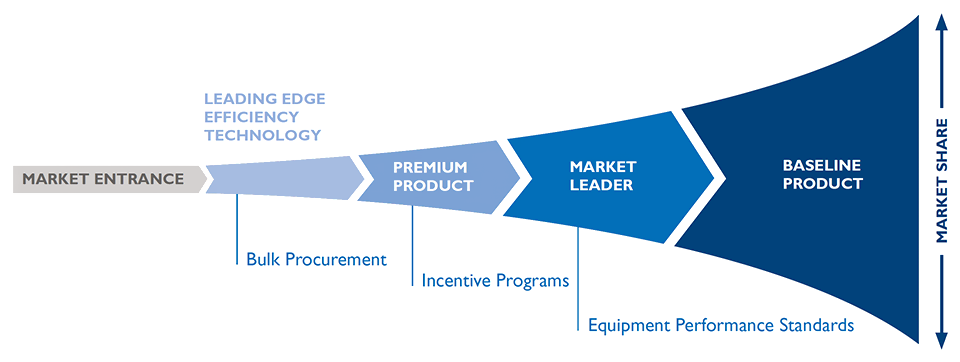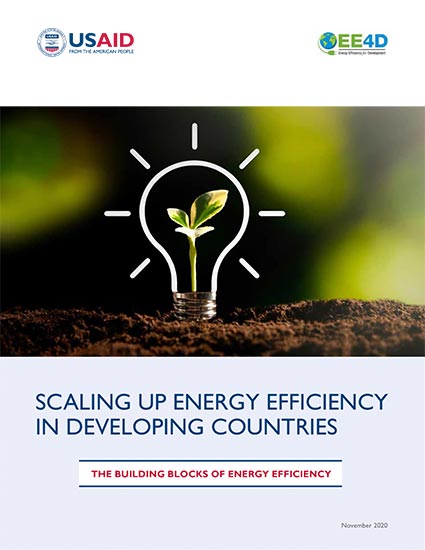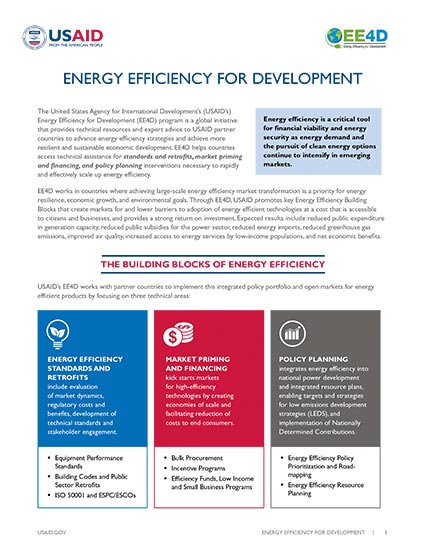- Energy Home
- How We Work
- Programs & Initiatives
- EmPOWERing Women and Girls
- Competitive Energy Procurement
- Toolkits
- Monitoring & Evaluation
- Resources
- Cost-Benefit Analysis of Off-Grid Solar
- DPV Impact on Utility Revenues and Electricity Tariffs
- Gender Equality in Renewable Energy
- Guide to Promoting an Energy Efficient Public Sector (PePS)
- Mobilizing Finance and Investment for Clean Energy
- Performance-Based Management Contracts
- Promoting Solar Energy in Haiti
- Scaling Up Energy Efficiency in Developing Countries
- Self-Reliance Through Electricity System Loss Reduction
- Stories
Speeches Shim
This document highlights the building blocks of solid energy efficiency policy planning and implementation in developing economies and provides practical information and strategies for implementation.
Energy efficiency is a critical tool for financial viability and energy security as energy demand and the pursuit of clean energy options continue to intensify in emerging markets.
The energy efficiency building blocks include 1) regulatory actions (standards) to “raise the floor” of efficiency of new equipment and construction, 2) market priming to pave the way for new technologies and thereby “raise the ceiling” of the market, and 3) integrated planning to prioritize energy efficiency in national economic and environmental policy. Well-designed technical assistance can provide the catalyst to pursue these programs and the expertise to help make them successful.
This document is meant as a resource for technical assistance programming that considers energy efficiency policy as a top priority for energy sector technical assistance, and treats it as an integrated whole with multiple interacting and self-reinforcing components.
Energy Efficiency Technologies and Policies
At its core, energy efficiency means minimizing the energy inputs needed to provide a desired energy service (i.e., using less electricity to power an office building). Energy efficiency decreases the financial costs of energy as well as other negative impacts associated with energy production and use.
Energy efficient technologies include equipment and materials designed to provide energy services with lower energy inputs compared to the status quo. Familiar examples of energy efficient technologies are electric lamps that produce the same light at lower wattage, refrigerators that cycle less often, fuel efficient cars, and heating systems that use less fuel than “baseline” technologies. Energy efficient technologies compete with conventional technologies and are selected by users who wish to reduce energy consumption in order to lower energy costs, benefit the environment, contribute to energy security, etc. They are often more expensive than conventional technologies, but provide a net positive financial return over time. Often, users do not select energy efficient technologies despite a favorable return on investment due to a variety of market failures including lack of information (consumers are not aware of benefits); lack of financing (consumers can’t afford up-front costs); or “split incentives” (e.g., building tenants do not install equipment but do pay energy bills).
Energy efficiency policies are actions taken by governments to address these market failures. Typically, energy efficiency policies provide net economic benefits to users while supporting other public goods, some of which are discussed in this paper. It is important to clarify what is meant by “policies,” how they differ from energy efficiency projects more generally, and how policies “act at scale.” All energy efficiency projects seek to reduce energy inputs and produce financial benefits. While a project may target a specific industrial facility or large commercial building, for example, policies create a set of rules and practices for an entire subsector or type of energy-using equipment. In doing so, they affect a much larger total energy footprint, often transforming national markets as a whole. While the resulting savings and benefits accrued may take years to be fully realized, the overall impact can be orders of magnitude larger and have a lasting effect on energy dynamics of an economy. For this reason, creating successful energy efficiency policies should be a top priority for governments.
Benefits of Energy Efficiency Policies for Developing Countries
After several decades of energy efficiency policy development in North America, Western Europe, Japan, Korea, and Australia, developing countries began to enact similar policies based on successful models. Despite the proliferation of policies, a close examination reveals that energy efficiency has yet to be scaled fully to meet societal needs in developing countries. A common justification for the lack of ambition in energy efficiency in developing countries is that they have more pressing priorities, including poverty reduction, access to basic services, economic development, acute inequality, and public safety. The unique and critical challenges faced by developing countries highlights the need for international assistance. Furthermore, an economy that incorporates energy efficiency measures can address some of these problems and boost the amount of financial resources a government has at its disposal.
Energy Efficiency Policies are Well-Suited to Meeting Developing Country Goals
As elsewhere, developing countries gain from energy efficiency in multiple ways, including increased energy security, job creation, and environmental mitigation. In addition, a particular benefit for economic development exists in reducing the expense of energy inputs that produce lower net economic output than other goods. Furthermore, energy efficiency contributes to reduction in the need for capital in the power sector and the cost of servicing loans supporting large-scale energy infrastructure.
Energy Efficient Technologies are Widely Available
Most of the technologies that do the “heavy lifting” of energy efficiency – efficient lighting for example– are globally traded commodities available to developing country consumers. The goal of energy efficiency policy is therefore to reduce the price and increase access to these, while giving local producers opportunities for export at the same time.
Policies are Well-Known with Lessons Learned
By now, there is a well-defined toolkit of energy efficiency policies with a proven track record, and these are generally known by responsible ministries and advocates in developing countries.
The Building Blocks of Energy Efficiency
Fortunately, the history of energy efficiency policies in major industrialized economies has paved the way for success. A fairly standard portfolio of policy tools exists with a strong track record of lowering energy intensity, saving consumers money and contributing to a cleaner environment. Many of these are found in the buildings sector, including households, businesses, and government.
ENERGY EFFICIENCY STANDARDS AND RETROFITS include evaluation of market dynamics, regulatory costs and benefits, development of technical standards and stakeholder engagement.
- Equipment Performance Standards
- Building Codes and Public Sector Retrofits
- ISO 50001 and ESPC/ESCOs
MARKET PRIMING AND FINANCING kick starts markets for high-efficiency technologies by creating economies of scale and facilitating reduction of costs to end consumers.
- Bulk Procurement
- Incentive Programs
- Efficiency Funds, Low Income and Small Business Programs
POLICY PLANNING integrates energy efficiency into national power development and integrated resource plans, enabling targets and strategies for low emissions development strategies (LEDS), and implementation of Nationally Determined Contributions.
- Energy Efficiency Policy Prioritization and Road-mapping
- Energy Efficiency Resource Planning
Strategies for Success
Despite their benefits, energy efficiency policies are perceived to be complex and difficult to implement. Technical assistance resources are indispensable to clarifying and simplifying each step in the process. While there is some standardization of technical assistance and tools, there is no “one-size-fits-all” approach to implementing good policy, since each country has unique priorities and limitations. Whatever the context, strategic implementation can greatly increase the chance of success.
Communicate Benefits Effectively
Political leaders at the national level of large developing countries usually have some understanding of the main energy efficiency policies but may not see them as core to their government’s mission and broader national goals. Furthermore, developing country governments may be most concerned about economic development, poverty alleviation, energy security, trade relations, or air pollution. Some of the most important but less-often communicated benefits of energy efficiency include economic development, job creation, energy security, reduced need for capital, and net subsidy reduction.
Design Integrated Programs
Successful and sustainable energy efficiency technical assistance follows a strategy of Integrated Policy Planning that deploys a complete set of tools with the long-term goal of reaching mass adoption of high-efficiency technologies.

As high-tech products enter the market, consumer awareness is boosted first by awards followed by government procurement guides, incentives, and labelling programs. Such programs boost market shares and create economies of scale that subsequently lower consumer prices. Once the technology becomes cost effective for most consumers, it can be considered for minimum efficiency standards and other policies that guarantee mass adoption. In countries where energy efficiency policies work together in this way, the process is cyclical, driving ever-increasing innovation.
Set Goals and Integrate Energy Efficiency in National Plans
Increasingly, developing country governments are setting forth long-term national goals related to energy efficiency. These goals should be quantified in terms of well-defined metrics. Furthermore, they should include both short and long time periods due to the nature of policies such as regulations for equipment production and building construction, which continue to have cumulative effects long after implementation. Like any program, support for energy efficiency benefits from rigorous monitoring and evaluation. Specific metrics to measure progress are energy savings and greenhouse gas emissions mitigation, financial benefits, development impacts, and increased technical capacity.



Comment
Make a general inquiry or suggest an improvement.